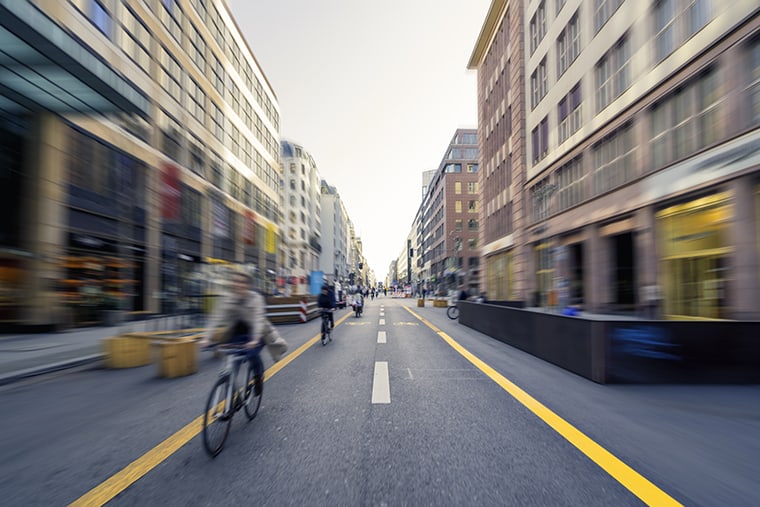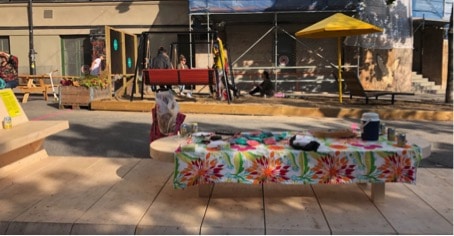
Transforming a street with a brushstroke: what does the future hold for tactical urbanism?
6 minutes of reading
During 2020, the term ‘tactical urbanism’ suddenly appeared on the front pages of the press to describe the arrangements being tested in the face of the COVID-19 crisis: pop-up ‘corona cycle lanes’ marked out in yellow on the streets or temporary terraces for restaurants and cafés instead of parking bays, for example. Light, low-cost, temporary and sometimes transitional, tactical urbanism has many advantages in the face of crisis. Do these facilities point to more permanent developments? How do you transition smoothly between two views of a street or a square? What are the social and cultural issues at stake, and what are the impacts in terms of use? What initiatives can come from the inhabitants of an area?

In response to new needs of inhabitants, to a change in the objectives of a city or in the face of a crisis, tactical urbanism enables a public space to be adapted very rapidly. In France, for example, the mobility challenges posed by the coronavirus crisis have encouraged many cities to create temporary facilities: 210 kilometres of temporary cycle lanes were created in the summer of 2020 in Greater Paris.[1] In fact, CEREMA (Centre for Studies and Expertise on Risks, the Environment, Mobility and Urban Planning) published an online guide to provisional cycling facilities in June 2020, [2] in response to this strong demand. But the term ‘tactical urbanism’ was not invented by local authorities or central political powers.

Inhabitants central to the process
The term was popularised in the United States in the 2000s at the initiative of citizens’ groups. Users, who lie at the centre of the approach, experiment with facilities that are set up quickly and at minimal cost. To do this, they use a range of tools, such as signage, paint, planting, urban furniture, elements suspended or fixed above the street, etc. The first experiments in tactical urbanism were informal and usually took place outside of any kind of framework. The concept was pioneered in 2005 by the Rebar collective, which temporarily transformed a San Francisco parking space into a ‘public park’ with a bench and a potted tree for two hours. Since then, this type of small-scale, low-cost temporary facility has spread around the world, notably during Park(ing) Day, a global event held on the third weekend of September. In Latin America, faced with the numerous daily road accidents in the Colombian city of Medellin, the “Movilidad Humana” collective has created minor but very visual layout changes at the intersection of two accident-prone avenues, in order to encourage motorists to slow down. These subtle changes, based on paint, planters and reflective strips, have produced conclusive results: the number of accidents at this location has been drastically reduced since they were made.Inventing new uses
Municipalities and local authorities are now making use of these tools. In Sweden, the national innovation agency Vinnova is now planning to transform all the country’s streets with the inhabitants by 2030. The method, “rethinking the space in front of your own and your neighbours’ front door”[3], is being tested in four cities and involves first of all transforming parking bays by installing removable, temporary modules featuring various types of urban furniture: benches, picnic tables, deckchairs, planters, etc. The broader social objective is to involve citizens in urban planning decisions, starting at their “door step”, and encourage them to take ownership of common spaces. Similarly, the New Zealand government has decided to invest more than NZ$7 million (€3.8 million) in a tactical urbanism project tender to redesign public spaces in New Zealand cities.[4]
Are there long-term ambitions hidden behind these temporary facilities?
Are tactical urbanism schemes set to disappear or to remain permanent? As part of a publication, we asked Benjamin Pradel, sociologist, consultant at Kaléido’Scop and co-founder of Intermède. His answer leaves the door open to different outcomes: “Temporary changes to the layout of public space, known as tactical changes, can have different outcomes.” In the context of particular events or crises, they may be genuinely temporary; but in other circumstances, they may prove so successful and popular that they become permanent: “Insofar as the benefits they bring are regarded as greater than the negative outcomes, they are made permanent and we then say that they were ‘transitional’ arrangements. ” Moreover, any temporary facility always leaves a mark in society. “We should bear in mind that reversing any development in the public space never means going back to the starting point. The physical embodiment of the development is reversible, but time is a continuum: whatever the development implemented, it will leave a mark on the uses it changes, the conflicts and debates that it gives rise to or the new representations of the places that it generates. ”[5]Transformation to transition
A parallel can then be drawn with transitional urbanism, applied here to public spaces. According to Benjamin Pradel, some developments are even specifically designed to transition towards something more permanent: they therefore “support a form of participation, communication or demonstration through use of what can be done in a development project. ” For example, some cities are initiating participatory approaches as a forerunner of a long-term plan. In October and November 2017, six workshops were held with Jersey City residents at locations deemed ‘unsafe’ for pedestrians. This involved changing the size of the pavements with ground paint, adding temporary furniture, facilitating signage, etc. These workshops provided feedback for the development of the city’s Pedestrian Plan. Similarly, in Miami, about a hundred parking spaces on Biscayne Boulevard were transformed into public spaces for three weeks. Dog parks, dance areas, seating areas and children’s playgrounds. This space attracted 17,000 people over a period of three weeks and consideration is now being given to the long-term conversion of car parks into public spaces and the redesigning of the boulevard. Paris is another example worth mentioning. After experimenting with temporary events – pedestrian Sundays and Paris Plage in August – for several years, the banks of the Seine have been made permanently pedestrian zones, first on the Left Bank and then on the Right Bank. However, this pedestrianisation itself includes a reversible approach: it was initially carried out with light, removable facilities, mostly made of wood, which could be quickly removed if the space had to be reopened to traffic or replaced by other facilities for other uses.Testing as a means of gaining valuable feedback
For example, the Paris Plage festivals and the pedestrian Sunday events not only tested traffic-free periods, but also popularised the use of the riverbanks by families, joggers and people just looking to relax, leading to rapid uptake of the new spaces after transformation – and this despite strong opposition from many road users. Similarly, the Colombian capital Bogotá introduced the Ciclovia or ‘cycling Sundays’ in the early 2000s, closing roads to motor vehicles in favour of bicycles. During the health crisis, the municipality adjusted the number of additional kilometres of cycle lanes to the need observed in real time. The minimal cost of tactical urbanism makes it possible to test solutions and capitalise on feedback, and to make facilities permanent in a more reasoned and thoughtful manner.In summary
Whether they are led by citizens’ groups, municipalities or other public institutions, rapidly implemented and cost-effective initiatives are emerging in cities. They may be temporary facilities or rolled out in a test phase before being potentially made permanent. These facilities may also be seen as a variation on reversibility in public spaces. To find out more, see the “Espaces Hybrides, Villes en Transition” (Hybrid Spaces, Cities in Transition) trend book, freely available on the Bouygues Construction blog (in French only).[6] [1] APUR, Note “La marche et le vélo plébiscités en période de crise sanitaire”, July 2020 [2] https://www.cerema.fr/fr/actualites/velo-deconfinement-guide-express-amenagements-cyclables [3] Dan Hill, TedX, November 2020, https://youtu.be/TZ60rMqdb0U [4] “Innovating Streets for People pilot fund”, www.nzta.govt.nz [5] Benjamin Pradel, “We must address the rhythms of the city in both their material and organisational dimensions”, Espaces Hybrides, Villes en Transition, Bouygues Construction, 2020. [6] https://www.bouygues-construction.com/blog/fr/non-classe/espaces-hybrides-villes-en-transition/Most read
More reading
Read also




What lies ahead? 7 megatrends and their influence on construction, real estate and urban development
Article
20 minutes of reading

